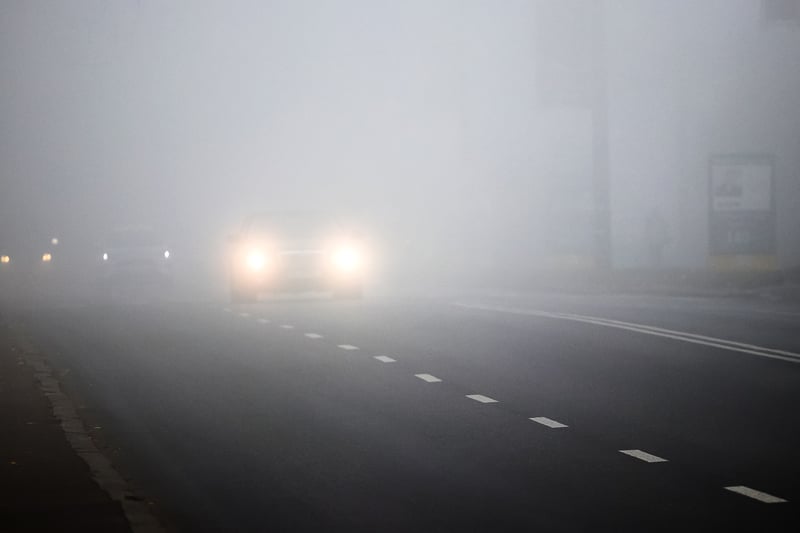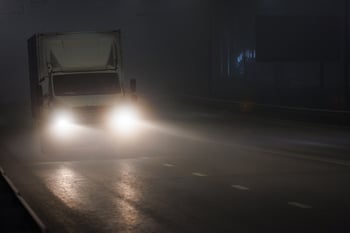Knowledge Center

You often hear a lot of talk about safe driving in snow, sleet, ice, rain, and blizzards. But there are other weather conditions that make for dangerous roads and lots of troubled drivers, such as fog. These dense “cloud banks” that rest on the ground can be scary to drive through, as it’s more difficult to see the road, signage, or other drivers and pedestrians. So, if you do find yourself driving in fog, here are some ways to reduce the risks and stay safe.
Avoid Driving in Bad Weather if Possible
For starters, if possible, avoid driving in tricky conditions altogether. Understandably, this is easier said than done since everyone has responsibilities that sometimes require driving regardless of weather hiccups, like getting to work and school, visiting doctors, and picking kids up from daycare. But if you can anticipate when less-than-ideal driving conditions will strike and you have the luxury to do so, you’re better off eliminating the risk by staying home or delaying the trip until conditions improve.
4 Tips for Safe Driving in Fog
With that said, here are four things to do if you end up encountering fog on the roads.
1. Slow Down & Keep Your Distance
Like in all other dangerous driving conditions, you should allow extra time for getting to your destination, drive slower than usual, and keep more distance between you and other cars. Reducing your speed is one of the most effective ways to prevent accidents, as it gives you more time to react. Remember that the posted speed limit refers to the maximum driving speed during ideal conditions; if the weather isn’t perfect, that speed is no longer appropriate.
2. Use Low Beams or Fog Lights
 As visibility is the primary concern with driving in fog, be sure your vehicle is visible to others ahead of you and behind you by using your low-beam headlights; doing so means your taillights will also be on. If your car has fog lights, you should use those. Either way, low beams and fog lights both perform better than headlights due to their low mounting point on the vehicle. Also, remember to never use your high-beam lights in foggy conditions. Using high beams causes glare, which will only make it more challenging to see what’s ahead of you on the road.
As visibility is the primary concern with driving in fog, be sure your vehicle is visible to others ahead of you and behind you by using your low-beam headlights; doing so means your taillights will also be on. If your car has fog lights, you should use those. Either way, low beams and fog lights both perform better than headlights due to their low mounting point on the vehicle. Also, remember to never use your high-beam lights in foggy conditions. Using high beams causes glare, which will only make it more challenging to see what’s ahead of you on the road.
3. Keep Your Windshield Clear
If it’s foggy, there’s a good chance it’s also raining or damp, which will only add to visibility problems. Keep your windshield clear by turning on windshield wipers or defrosters, whichever is appropriate. You should always maintain clean windshields anyway, as dirt and grime buildup further obstruct your view on bad weather days.
4. Know When to Pull Over
If things worsen during your drive or the fog gets too thick, you can always pull over and wait; just do so safely.
- Don’t brake so suddenly. Use directionals when pulling off or turning.
- Turn on your hazard lights to alert other drivers to where you are.
- If possible, pull off into a parking lot or onto a less busy side street.
- If you must pull over on the side of the road, try to get as far away from the road as possible so others don’t think you’re part of moving traffic.
Regardless of whether you’re in a car collision caused by poor weather (like fog), other careless drivers, or just genuine accidents, you should rest assured knowing your auto insurance provider has you covered in all these incidents.
This article is not intended to be exhaustive, nor should any discussion or opinions be construed as legal advice. Readers should contact legal counsel or an insurance professional for appropriate advice.
This article is not intended to be exhaustive, nor should any discussion or opinions be construed as legal advice. Readers should contact legal counsel or an insurance professional for appropriate advice.
About the Author
We’re ready to help you
protect what matters most
Discuss your options for protecting your reputation and your business.

